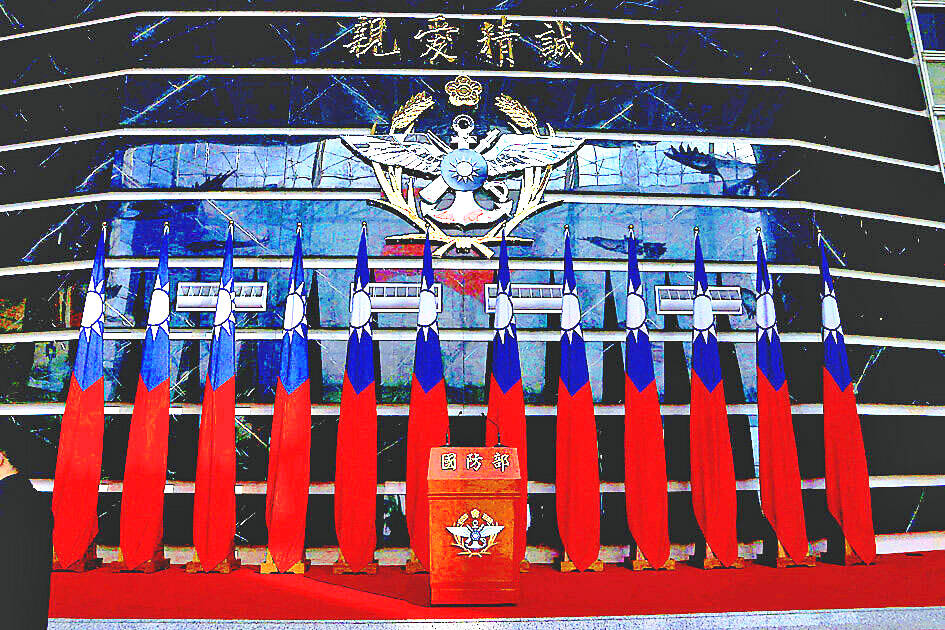A drone countermeasure system to be used by the army would be completed by the end of this year at a cost of NT$988 million (US$30.1 million), the Ministry of National Defense said.
The contract was won by Tron Future Tech Inc (創未來科技) after previously failed bids, the ministry said on Friday, adding that the company would finish production of the systems by the end of the year, with initial deployments in Kinmen and Lienchiang countries, as well as at the army’s base in Taoyuan’s Longtan District (龍潭).
China’s incursions into airspace and waters near Taiwan have increasingly included drone activity, which necessitates actions to protect national security, the ministry said.

Photo: Ann Wang, Reuters
“Small and medium-sized drones frequently harass our outlying islands, and there have even been drone swarm attacks to test the army’s defense capabilities,” it said.
In addition to the army’s drone countermeasure system, the ministry said it is also planning to purchase a “remote control drone defense system” for the air force, which has a budget of NT$4.35 billion.
The ministry would commission the Chung-Shan Institute of Science and Technology to build the system and purchase jammers, it said.
“The system would be aimed at defending against incursions by Chinese drones, as well as protecting bases, ports, airports and other such areas,” the ministry said.
Drones and anti-drone defense systems would eventually be installed at outlying islands, isolated military camps, high-mountain facilities, missile-launch positions and other sensitive areas, it added.
The systems would allow the military to conduct reconnaissance and interfere with intruder uncrewed aerial vehicles, improve base security, maintain flight safety, and provide better wartime defense and combat capabilities, the ministry said.
Prior to winning the bid for the drone countermeasure system, Tron Future had taken its system to test sites in Yilan and Kinmen counties, a source said.
“The military was not satisfied with the initial tests, so it asked the contractor to make improvements, which it did, and it finally met the ministry’s requirements,” they said.
According to Tron Future’s Web site its anti-drone system is comprised of three components: a radar, a jammer and an interceptor drone.
The interceptor “has a radar and image seeker with choices of explosive or non-destructive warheads for dealing with different situations. [It] flies back to the desired location when an intercept mission is complete,” it says.

Three Taiwanese airlines have prohibited passengers from packing Bluetooth earbuds and their charger cases in checked luggage. EVA Air and Uni Air said that Bluetooth earbuds and charger cases are categorized as portable electronic devices, which should be switched off if they are placed in checked luggage based on international aviation safety regulations. They must not be in standby or sleep mode. However, as charging would continue when earbuds are placed in the charger cases, which would contravene international aviation regulations, their cases must be carried as hand luggage, they said. Tigerair Taiwan said that earbud charger cases are equipped

UNILATERAL MOVES: Officials have raised concerns that Beijing could try to exert economic control over Kinmen in a key development plan next year The Civil Aviation Administration (CAA) yesterday said that China has so far failed to provide any information about a new airport expected to open next year that is less than 10km from a Taiwanese airport, raising flight safety concerns. Xiamen Xiangan International Airport is only about 3km at its closest point from the islands in Kinmen County — the scene of on-off fighting during the Cold War — and construction work can be seen and heard clearly from the Taiwan side. In a written statement sent to Reuters, the CAA said that airports close to each other need detailed advanced

Tropical Storm Fung-Wong would likely strengthen into a typhoon later today as it continues moving westward across the Pacific before heading in Taiwan’s direction next week, the Central Weather Administration (CWA) said. As of 8am, Fung-Wong was about 2,190km east-southeast of Cape Oluanpi (鵝鑾鼻), Taiwan’s southernmost point, moving westward at 25kph and possibly accelerating to 31kph, CWA data showed. The tropical storm is currently over waters east of the Philippines and still far from Taiwan, CWA forecaster Tseng Chao-cheng (曾昭誠) said, adding that it could likely strengthen into a typhoon later in the day. It is forecast to reach the South China Sea

WEATHER Typhoon forming: CWA A tropical depression is expected to form into a typhoon as early as today, the Central Weather Administration (CWA) said yesterday, adding that the storm’s path remains uncertain. Before the weekend, it would move toward the Philippines, the agency said. Some time around Monday next week, it might reach a turning point, either veering north toward waters east of Taiwan or continuing westward across the Philippines, the CWA said. Meanwhile, the eye of Typhoon Kalmaegi was 1,310km south-southeast of Oluanpi (鵝鑾鼻), Taiwan’s southernmost point, as of 2am yesterday, it said. The storm is forecast to move through central